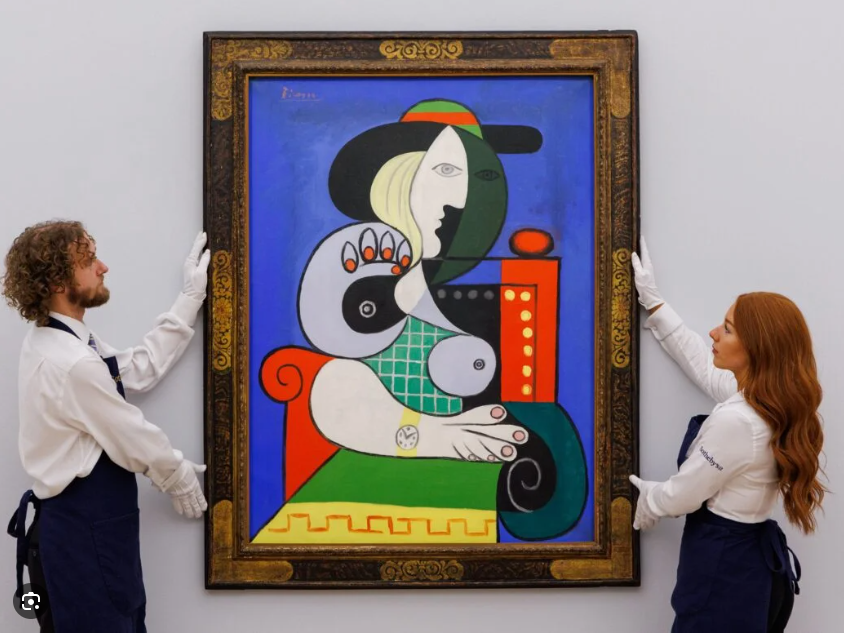Picasso’s painting “Woman with a Clock” went under the hammer for $139.36 million

In a stunning display of art market strength, Pablo Picasso's "Woman with a Clock," an evocative symbol of temporal beauty and romantic decay, fetched a monumental $139.364 million at Sotheby’s auction house, catapulting the value of the Spanish maestro's work into the upper echelons of the fine art world.
Picasso, the iconic figure of 20th-century art, has long captured the imagination and pockets of collectors with his unique style and emotionally charged compositions. The 1932 masterpiece portrays Marie-Therese Walter, Picasso's lover and muse, adorned with a wristwatch. Lydia Gasman, an esteemed researcher of Picasso’s oeuvre, interpreted the inclusion of timepieces in his work as metaphorical, intertwining the relentless passage of time with the consuming nature of love.
This painting, with its rich historical tapestry, was initially acquired directly from Picasso by the Beyeler Gallery in Basel, 1966, and shortly thereafter, in 1968, became a part of the prestigious collection at Pace Gallery in New York. It was later obtained by American collector Emily Fisher Landau, known for her discerning eye and profound influence in the art world.
For decades, "Woman with a Clock" held a place of honor above the mantelpiece in Landau’s private residence, silently witnessing the ebbs and flows of an art-filled life. Following her death in 2023, the destiny of the painting was entrusted to Sotheby's, as they were granted the right to handle the sale of Landau’s remarkable collection, comprising roughly 120 works valued cumulatively at around $400 million.
The sale of "Woman with a Clock" not only signifies a milestone in auction history but also marks the ongoing relevance and fascination with Picasso's creative genius. The painting's allure, amplified by its provenance and Landau's legacy, has secured its place as one of the most coveted Picasso paintings ever to grace the auction stage.
Collectors and admirers from around the globe watched with bated breath as bids escalated in a fervent ballet of raising paddles and nodding heads. The final hammer price, surpassing estimates and shattering records, was met with a mixture of awe and applause. The anonymous buyer, now the custodian of this priceless work, remains in the shadows, adding yet another layer of intrigue to the painting’s storied existence.
The triumph of "Woman with a Clock" underscores a broader narrative about the enduring allure of fine art as both a cultural artifact and a financial asset. Despite economic uncertainties and global challenges, the art market continues to exhibit a robust appetite for works of significant historical and artistic value. Picasso, through his innovative techniques and emotionally resonant themes, remains a towering figure whose works are not merely admired but are also seen as a testament to the human spirit's complexities.
This painting's record-breaking sale will undoubtedly reverberate through the halls of auction houses and galleries worldwide, potentially influencing future valuations of similar works. It raises pertinent questions about the valuation of art, the motivations of collectors, and the role of art as a marker of both personal and collective histories.
"Woman with a Clock" is more than a painting; it is a conversation between past and present, a silent observer of the transient nature of life and love, now etched into the annals of art history with a price tag that speaks volumes about its perceived value. As it transitions into new hands, the painting carries with it the echoes of the past—of Picasso's brush strokes, of Marie-Therese's gaze, of Landau's appreciation, and of the countless viewers who have stood before it, contemplating the relentless ticking of the clock and the fleeting moments it captures.
The sale also potentially marks a turning point for Sotheby's, cementing its status as a major player in the art market, capable of orchestrating sales of monumental importance. It demonstrates the power of provenance and the narrative attached to a work of art, factors that can exponentially increase an artwork's appeal and economic worth.
In the wake of this historic sale, the art community is left to ponder the future trajectory of the market. Will Picasso's "Woman with a Clock" represent the high-water mark for the foreseeable future, or is it a harbinger of even more astounding sales to come? Only time, ever the central theme of Picasso's painting, will tell.
As the art world continues to grapple with the implications of such a momentous transaction, "Woman with a Clock" serves as a potent reminder of art's unique ability to encapsulate human emotion, to command attention, and to fetch a price that reflects its inimitable fusion of history, beauty, and intrigue. It stands as a testament to the fact that, even in a digitized, fast-paced world, the value of a timeless masterpiece only grows, as inexorable as the passage of time it so elegantly embodies.